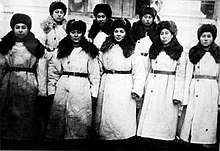Ili National Army
The Ili National Army (Chinese: 伊犁民族军) was the army of the East Turkestan Republic (ETR) that originally consisted of six regiments: the Suidun Infantry Regiment, the Ghulja Regiment, the Kensai Regiment, the Ghulja Reserve Regiment, the Kazakh Cavalry Regiment, the Dungan Regiment, the Artillery Subdivision, the Sibo Subdivision, and the Mongol Subdivision. The last two subdivisions were later reformed to regiments. All regiments were armed with mostly German-made weapons, provided by the Soviet Union by order of Joseph Stalin ; its personnel was trained in the Soviet Union. Rebel aviation included 42 airplanes, captured in Ghulja Kuomintang air base and repaired by Soviet military personnel.[1]
| Ili National Army | |
|---|---|
 Female soldiers, circa 1946 | |
| Founded | 8 April 1945 – 20 December 1949 |
| Country | |
| Branch | Army |
| Size | 50,000 infantry and 100,000 irregular reserves |
| HQ | Gulija |
| Nickname(s) | Milli Armiye (National Army) |
| Colors | Blue and white |
| March | Kozghal! (Arise!) |
| Equipment | 12 artillery pieces 42 Fighter plane |
| Engagements | Ili Rebellion Chinese Civil War |
| Commanders | |
| Marshal-in-chief | Elihan Tore |
| Political commissar | Abdulkerim Abbas |
| Notable commanders | General Isaqbeg, General Delilqan, Major Barat Hacı |
History
The Ili National Army was formed on 8 April 1945. Elihan Tore was the Marshal of the Ili National Army until his exile to the Soviet Union.[2] Abdulkerim Abbas served as the INA's political director.[3]
According to M. Kutlukov, in September 1945, the Ili National Army made decisive victories over Kuomintang troops in Jungaria, where two newly formed full-sized Kuomintang divisions of around 25,000 troops, armed with American-made weapons, were trapped and completely annihilated (except for 6,000 soldiers and officers, including 7 generals, who surrendered) in battles in the highly fortified Wusu-Shihezi district. This was in part thanks to the courage of soldiers and officers of the Ili National Army, the experience of numerous Soviet military personnel and advisers who directly participated in the military operations, and the employment of heavy artillery fire and aerial bombings (by rebel aviation) of Kuomintang positions in the strategic oil rich district.
On 20 December 1949, the Ili National Army joined the People's Liberation Army as the Xinjiang 5th Corps, but then was reformed; its divisions were transferred to the newly created Xinjiang Production and Construction Corps with all weapons of the divisions having been seized. Later these national divisions were disbanded, and most of its personnel were imprisoned, executed, or had fled to the Soviet Union.
Notes
- "East Turkestan Republic (1944-1949) in Xinjiang as part of Uyghur independence East Turkestan." M. Kutlukov, Tashkent, 1958, Academy of Sciences of USSR
- Millward 2007: 219.
- (in Chinese) 哈吉娅•阿巴斯, 宣传党的民族政策——我的父亲阿不都克里木·阿巴索夫 (2) 中直育英同学会 2014-03-14.
References
- Millward, James A. (2007). Eurasian Crossroads: A History of Xinjiang. Columbia University Press. ISBN 978-0231139243.
Further reading
- William W. Whitson, with Chen-hsia Huang. (1973) The Chinese high command – A history of Communist military politics, 1927–71. Foreword by Lucian W. Pye.